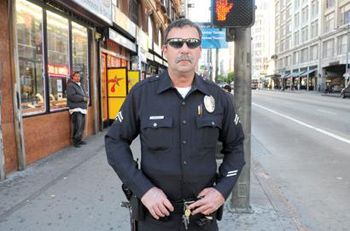
Officer Stephen Nichols, who patrols the Historic Core, will employ a zero tolerance policy for jaywalking. Drivers whose cars are stuck in intersections at red lights will also be cited. (Photo by Gary Leonard)
Shoppers cruising the Historic Core for gifts this holiday season, be warned: If you cross the street against the blinking red light, or forego a crosswalk altogether, the LAPD will stick its special brand of coal in your stocking.
It comes in the form of a ticket, and it'll cost you $190.
In anticipation of busy sidewalks and busier streets, Central Area police officials plan to ramp up enforcement of pedestrian infractions to tide off accidents and keep traffic flowing. The crackdown was slated to start the day after Thanksgiving in the Historic Core and the Jewelry and Fashion Districts (after Los Angeles Downtown News went to press).
"It's a double-edged sword because a lot of people want a high police presence and enforcement, but they don't want a jaywalking ticket," said Central Area Capt. Todd Chamberlain. "But we feel it's imperative."
Last year, between Nov. 25 and Dec. 31, there were three accidents involving a vehicle and a pedestrian. Two resulted in serious injury to the pedestrian and were the walker's fault, said Lt. Paul Vernon. A third accident that resulted in a pedestrian's death was blamed on a speeding driver, he said.
During the rest of the year, an average of less than one person a month is hit by a car on Downtown streets.
Senior Lead Officer Stephen Nichols, who patrols the Historic Core, said he'll be taking a zero tolerance approach not just on jaywalking, but on all moving violations he sees, including those committed by vehicles.
For example, Nichols said he'll ticket drivers who inch into an intersection while the light is green, but remain there after it turns red because traffic is backed up in front of them. The scenario results in gridlock because it blocks traffic in the other direction, and it endangers pedestrians who often cross the street before letting the stuck car pass, he said.
"It's not to punish as much as it is to enforce and to educate, to remind them that even though they're aware of vehicle traffic, vehicle traffic may not be aware of them," Nichols said.
Russell Brown, executive director of the Historic Downtown Business Improvement District, welcomes the crackdown on drivers who block intersections, but questions the zero tolerance policy on jaywalking. If, for example, someone crosses in the crosswalk, and hustles across the street while the red light is flashing and the countdown has several seconds to go before hitting zero, a ticket seems like overkill, he said.
"For folks who are going through the crosswalks and they're not super familiar with the neighborhood, and they're using some degree of common sense but the police are zero tolerance, it's not the most welcoming thing for patrons down here," Brown said. "If you can accomplish the same goals by helping to educate people but not punish them, especially if it's not life-threatening, I think it's a better tactic."
Annual Rituals
Across the city, as families gather for Thanksgiving feasts and prepare for gift-giving holidays, police districts with shopping hubs face their own year-end ritual. They must strategize on how to nip in the bud the crimes that coincide with high foot traffic and shopping.
"It's simple," Vernon said. "There's more people with things worth stealing."
In Downtown, the holidays traditionally coincide with a spike in car break-ins and stolen vehicles. Shoppers too frequently leave their bags and merchandise in their locked cars in plain view, said Vernon.
That said, last year defied the norm, as overall crime during the final 45 days of 2009 did not spike. In fact, several categories of serious crime, including robberies and aggravated assaults, fell in that timeframe compared to the average 45-day period for the year.
Additionally, Vernon said, crimes involving cars increased only slightly. There were 108 burglaries or thefts from vehicles, or 8.3% more than the 45-day average of 99 (burglaries in general were up 14%). There were 41 car thefts, or two more than the average of 39.
Vernon attributed the minimal increase to police strategizing in advance of the expected crime surge. They plan to do the same this year. In the Fashion District, that will mean heightened enforcement on illegal street vendors, who might try to take advantage of larger pedestrian crowds, Chamberlain said. Other times, the vendors are the targets themselves of gang members engaged in extortion efforts.
The Fashion and Jewelry districts, along with the Historic Core, can also expect an increase in uniformed officers on the street, on foot or on bike. The heightened patrols will draw on existing budget resources, not overtime, Chamberlain said.
The area's top cop knows that the pedestrian crackdown will be scorned by some, specifically those who receive a ticket for the holidays.
"It's not the most heinous crime that's out there that the Central officers deal with by any means," said Chamberlain.
Indeed, jaywalking isn't really even a crime. It's an infraction. But that will be of little solace to those who still have to pay the ticket.











